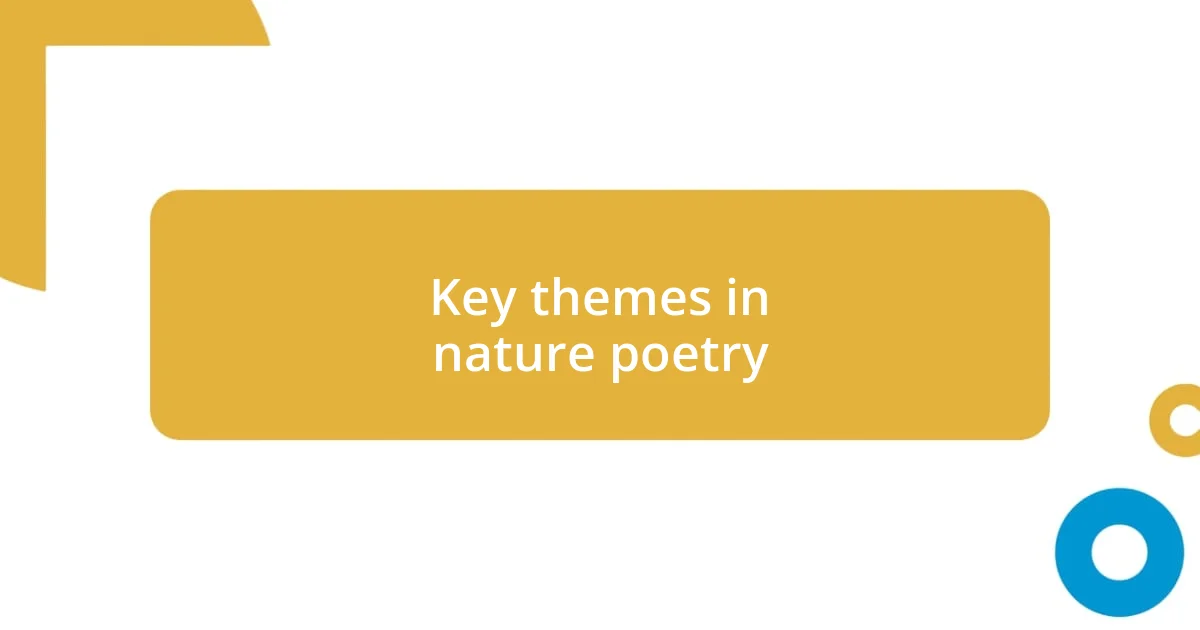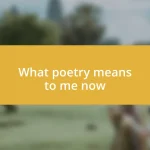Key takeaways:
- Nature poetry encompasses various forms such as haiku, sonnets, and free verse, each capturing unique aspects of the natural world.
- Key themes in nature poetry include transience, connection to nature, natural beauty, human impact on the environment, and the cycles of life.
- Creating vivid imagery in poetry relies on sensory language, metaphors, and rhythm, enhancing the reader’s emotional experience and connection to nature.

Understanding nature poetry forms
When I dive into the world of nature poetry, I find that the various forms each bring a unique flavor to the experience. For instance, the simplicity of a haiku captures a fleeting moment in nature, allowing the reader to pause and reflect. Can you remember a time when just a few words struck a chord in your heart, evoking the beauty of a single blossom or the stillness of a quiet forest?
As I explore sonnets, I’m often struck by their structured elegance, where the rhythm almost mimics the pulse of nature itself. These poems invite a deeper examination of themes such as change, beauty, and decay. I can’t help but wonder—how does the play between structure and freedom in poetry mirror the contrasts we observe in nature?
Then there are free verse poems, which I absolutely cherish for their fluidity and spontaneity. They reflect the unpredictable essence of nature, much like a windy day that tosses leaves around without a care. In these moments, I feel a strong connection to the natural world, as if the lines of the poetry are as unrestrained as the rivers flowing through a landscape. Have you ever felt that the words on the page seem to dance just like the leaves in the breeze?

Key themes in nature poetry
In my exploration of nature poetry, several themes consistently emerge as profound reflections of our relationship with the natural world. For example, I often find myself relating to the theme of transience, that fleeting beauty of a sunset or the brief flowering of cherry blossoms. These moments remind me of my own experiences, like the time I witnessed a breathtaking sunset on a camping trip; it was as if nature was whispering to me about the impermanence of life itself.
Key themes in nature poetry include:
- Transience and Change: The recognition that nature is constantly evolving, urging us to appreciate every moment.
- Connection to Nature: A profound bond that poets often express, drawing parallels between natural beauty and human emotion.
- Natural Beauty and Wonder: The awe-inspiring elements of nature that evoke feelings of joy, solace, and introspection.
- Human Impact on Nature: A reflection on the often turbulent relationship between humanity and the environment, raising awareness about issues like conservation.
- Cycles of Life: The focus on birth, growth, decay, and renewal found in ecosystems, mirroring our own life journeys.
As I reflect on these themes, I can’t help but think of the poems that resonate with me during quiet walks in the woods. There’s something special about seeing how poets depict the symphony of life unfolding around us, often reflecting my own thoughts and feelings as I breathe in the fresh air.

Influential nature poets and works
One poet who stands out in the realm of nature poetry is William Wordsworth. His work, particularly “Lines Written a Few Miles Above Tintern Abbey,” encapsulates the profound connection between nature and the human soul. I can’t help but recall the first time I read it; it felt as though Wordsworth was articulating the unspoken reflections of my own nature walks, where I found solace and inspiration in the simple beauty surrounding me.
Next, let’s consider Mary Oliver, whose poem “Wild Geese” resonates with many because of its accessible yet impactful message. Her invitation to embrace our own place in the natural order struck me deeply, especially during a season of personal uncertainty. I remember walking by a lake, where the wild geese flew overhead, their calls echoing Oliver’s words. It was a reminder that we are all part of something greater, urging me to step outside my worries and immerse myself in the present.
Lastly, there’s John Keats with his masterpiece, “To Autumn,” which embodies the essence of nature’s cycles through rich imagery and sensory details. Keats’ ability to blend beauty with the passage of time always leaves me in awe. I vividly remember a late autumn day when I sat among the fallen leaves, the crisp scent of decay in the air, and I felt a deep kinship with Keats’ celebration of autumn’s bounty. This poem encapsulates not just the beauty of nature but also the bittersweet acknowledgment of approaching change.
| Poet | Notable Work |
|---|---|
| William Wordsworth | “Lines Written a Few Miles Above Tintern Abbey” |
| Mary Oliver | “Wild Geese” |
| John Keats | “To Autumn” |

Crafting your own nature poetry
When I set out to write nature poetry, I often draw inspiration from my surroundings, using the world around me as my canvas. I remember one quiet morning when I lingered by a riverside, captivated by the way the sunlight danced on the water. This moment sparked an urge to capture the beauty in words, to paint with my pen what my eyes beheld. How often do we overlook those stunning details in everyday life?
In crafting my own verses, I find it helpful to embrace my emotions fully. At times, I write about the thunderous storm, which mirrors my internal struggles, while at other moments, I channel the stillness I feel during a serene sunrise. I believe that tapping into our personal emotional landscape can create a bridge between the reader and the beauty of nature. Isn’t it fascinating how a simple experience in nature can evoke such deep feelings?
Finally, I encourage experimentation with form and style. I once tried writing haikus while sitting under a blooming cherry tree, focusing on distilling the essence of that fleeting moment into just a few words. The challenge was exhilarating. Learning to express life’s complexities in brevity not only sharpened my writing but changed how I observed nature. Have you ever felt that spark of creativity from a spontaneous moment outside? It’s magical how nature can be our best muse.

Techniques for vivid imagery
To create vivid imagery in nature poetry, the use of sensory language is essential. I remember watching a sunset one evening, where the sky transformed into a canvas of oranges and purples, colors so rich they felt tangible. Describing this scene required more than just stating the colors; I had to evoke the warmth of the fading sun and the coolness of the approaching night. Isn’t it astonishing how words can transport us back to a moment with just a few detailed descriptions?
Metaphors and similes can also breathe life into poetry, making abstract ideas concrete. For instance, I once compared the roar of the ocean to the fierce whispers of forgotten dreams crashing against the shore. This not only painted a picture but also conveyed a deeper emotional resonance. Think about how those comparisons can connect readers to the feelings that nature evokes; they serve as a bridge between the physical and the emotional realms.
Finally, I find that rhythm and sound play a crucial role in creating imagery that sticks with the reader. The cadence of my lines can mimic the ebb and flow of nature itself, like the rustling leaves or the gentle lapping of water against the rocks. One time, as I listened to a gentle rain pattering against my window, I was inspired to structure my poem in a way that reflected its rhythm. How does a poem feel when its flow aligns with the natural world? This harmony can make the imagery not only seen but felt, creating an experience that lingers long after the last line is read.

Sharing and discussing nature poetry
Sharing nature poetry often opens up engaging conversations that deepen our connection to the environment and each other. I recall a lively discussion I had at a local poetry reading, where everyone shared their interpretations of a poem focused on a lone tree standing against an evening sky. Hearing different perspectives added layers to my understanding, making me appreciate how personal experiences color our interpretations of nature’s beauty. Have you ever shared your thoughts and found new meanings in someone else’s insights?
When discussing nature poetry, we naturally reflect on our individual encounters with the natural world. I remember sharing a piece inspired by a winter hike, where my words evoked the crispness of air and the crunch of snow underfoot. As I spoke about the tranquility of a serene forest, I could see nods of recognition from the audience, with eyes glistening as they recalled their own similar experiences. Isn’t it amazing how poetry can create such a shared sense of belonging and nostalgia?
Collaborative sharing can be a transformative experience. I once participated in a workshop where we exchanged poems and offered feedback. Each critique felt like a gentle nudge toward artistic growth, prompting me to explore themes I had never considered before. Engaging with fellow poets not only invigorated my writing but also deepened my appreciation for the diverse ways we all connect to the beauty of nature. Have you ever experienced a moment where feedback transformed your perspective? It’s these interactions that breathe life into our poetic journeys.












